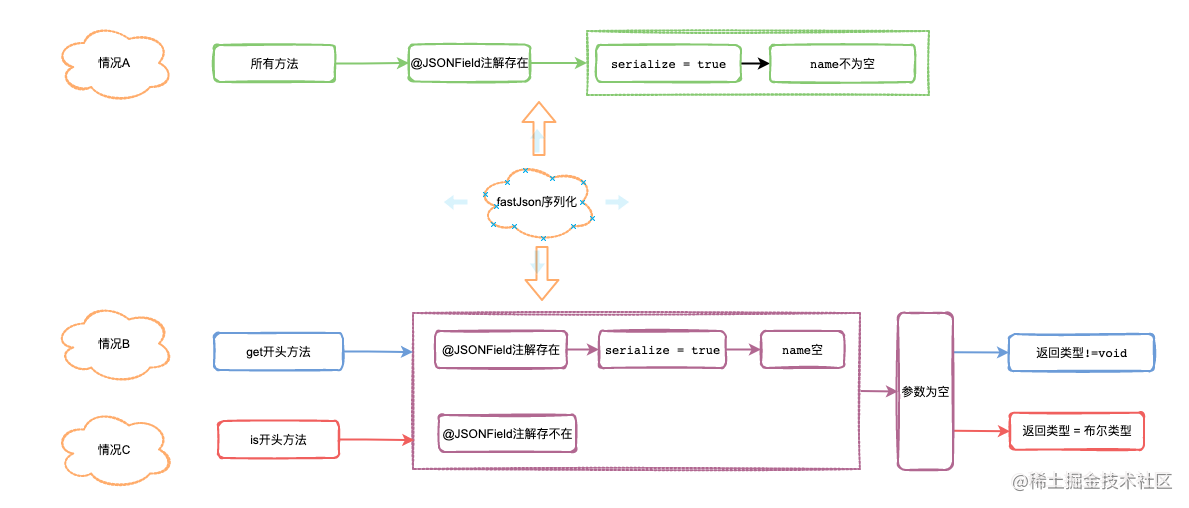我就往代码加了一行 log 日志,结果引发了 P1 级线上事故。。大家注意!
作者:老鹰汤
链接:https://juejin.cn/post/7156439842958606349
线上事故回顾
前段时间新增一个特别简单的功能,晚上上线前review代码时想到公司拼搏进取的价值观临时加一行log日志,觉得就一行简单的日志基本上没啥问题,结果刚上完线后一堆报警,赶紧回滚了代码,找到问题删除了添加日志的代码,重新上线完毕。
情景还原
定义了一个
CountryDTO
public class CountryDTO {
private String country;
public void setCountry(String country) {
this.country = country;
}
public String getCountry() {
return this.country;
}
public Boolean isChinaName() {
return this.country.equals("中国");
}
}
定义测试类
FastJonTest
public class FastJonTest {
@Test
public void testSerialize() {
CountryDTO countryDTO = new CountryDTO();
String str = JSON.toJSONString(countryDTO);
System.out.println(str);
}
}
运行时报空指针错误:  通过报错信息可以看出来是 序列化的过程中执行了
通过报错信息可以看出来是 序列化的过程中执行了 isChinaName()方法,这时候this.country变量为空, 那么问题来了:
- 序列化为什么会执行
isChinaName()呢? - 引申一下,序列化过程中会执行那些方法呢?
源码分析
通过debug观察调用链路的堆栈信息  调用链中的
调用链中的ASMSerializer_1_CountryDTO.write是FastJson使用asm技术动态生成了一个类ASMSerializer_1_CountryDTO,
asm技术其中一项使用场景就是通过到动态生成类用来代替
java反射,从而避免重复执行时的反射开销
JavaBeanSerizlier序列化原理
通过下图看出序列化的过程中,主要是调用JavaBeanSerializer类的write()方法。  而
而JavaBeanSerializer 主要是通过 getObjectWriter()方法获取,通过对getObjectWriter()执行过程的调试,找到比较关键的com.alibaba.fastjson.serializer.SerializeConfig#createJavaBeanSerializer方法,进而找到 com.alibaba.fastjson.util.TypeUtils#computeGetters
public static List<FieldInfo> computeGetters(Class<?> clazz, //
JSONType jsonType, //
Map<String,String> aliasMap, //
Map<String,Field> fieldCacheMap, //
boolean sorted, //
PropertyNamingStrategy propertyNamingStrategy //
){
//省略部分代码....
Method[] methods = clazz.getMethods();
for(Method method : methods){
//省略部分代码...
if(method.getReturnType().equals(Void.TYPE)){
continue;
}
if(method.getParameterTypes().length != 0){
continue;
}
//省略部分代码...
JSONField annotation = TypeUtils.getAnnotation(method, JSONField.class);
//省略部分代码...
if(annotation != null){
if(!annotation.serialize()){
continue;
}
if(annotation.name().length() != 0){
//省略部分代码...
}
}
if(methodName.startsWith("get")){
//省略部分代码...
}
if(methodName.startsWith("is")){
//省略部分代码...
}
}
}
从代码中大致分为三种情况:
@JSONField(.serialize = false, name = "xxx")注解getXxx(): get开头的方法isXxx():is开头的方法
序列化流程图

示例代码
/**
* case1: @JSONField(serialize = false)
* case2: getXxx()返回值为void
* case3: isXxx()返回值不等于布尔类型
* case4: @JSONType(ignores = "xxx")
*/
@JSONType(ignores = "otherName")
public class CountryDTO {
private String country;
public void setCountry(String country) {
this.country = country;
}
public String getCountry() {
return this.country;
}
public static void queryCountryList() {
System.out.println("queryCountryList()执行!!");
}
public Boolean isChinaName() {
System.out.println("isChinaName()执行!!");
return true;
}
public String getEnglishName() {
System.out.println("getEnglishName()执行!!");
return "lucy";
}
public String getOtherName() {
System.out.println("getOtherName()执行!!");
return "lucy";
}
/**
* case1: @JSONField(serialize = false)
*/
@JSONField(serialize = false)
public String getEnglishName2() {
System.out.println("getEnglishName2()执行!!");
return "lucy";
}
/**
* case2: getXxx()返回值为void
*/
public void getEnglishName3() {
System.out.println("getEnglishName3()执行!!");
}
/**
* case3: isXxx()返回值不等于布尔类型
*/
public String isChinaName2() {
System.out.println("isChinaName2()执行!!");
return "isChinaName2";
}
}
运行结果为:
isChinaName()执行!!
getEnglishName()执行!!
{"chinaName":true,"englishName":"lucy"}
代码规范
可以看出来序列化的规则还是很多的,比如有时需要关注返回值,有时需要关注参数个数,有时需要关注@JSONType注解,有时需要关注@JSONField注解;当一个事物的判别方式有多种的时候,由于团队人员掌握知识点的程度不一样,这个方差很容易导致代码问题,所以尽量有一种推荐方案。 这里推荐使用@JSONField(serialize = false)来显式的标注方法不参与序列化,下面是使用推荐方案后的代码,是不是一眼就能看出来哪些方法不需要参与序列化了。
public class CountryDTO {
private String country;
public void setCountry(String country) {
this.country = country;
}
public String getCountry() {
return this.country;
}
@JSONField(serialize = false)
public static void queryCountryList() {
System.out.println("queryCountryList()执行!!");
}
public Boolean isChinaName() {
System.out.println("isChinaName()执行!!");
return true;
}
public String getEnglishName() {
System.out.println("getEnglishName()执行!!");
return "lucy";
}
@JSONField(serialize = false)
public String getOtherName() {
System.out.println("getOtherName()执行!!");
return "lucy";
}
@JSONField(serialize = false)
public String getEnglishName2() {
System.out.println("getEnglishName2()执行!!");
return "lucy";
}
@JSONField(serialize = false)
public void getEnglishName3() {
System.out.println("getEnglishName3()执行!!");
}
@JSONField(serialize = false)
public String isChinaName2() {
System.out.println("isChinaName2()执行!!");
return "isChinaName2";
}
}
三个频率高的序列化的情况
 以上流程基本遵循 发现问题 –> 原理分析 –> 解决问题 –> 升华(编程规范)。
以上流程基本遵循 发现问题 –> 原理分析 –> 解决问题 –> 升华(编程规范)。
- 围绕业务上:解决问题 -> 如何选择一种好的额解决方案 -> 好的解决方式如何扩展n个系统应用;
- 围绕技术上:解决单个问题,顺着单个问题掌握这条线上的原理。
近期热文推荐:
1.1,000+ 道 Java面试题及答案整理(2022最新版)
2.劲爆!Java 协程要来了。。。
3.Spring Boot 2.x 教程,太全了!
4.别再写满屏的爆爆爆炸类了,试试装饰器模式,这才是优雅的方式!!
5.《Java开发手册(嵩山版)》最新发布,速速下载!
觉得不错,别忘了随手点赞+转发哦!


